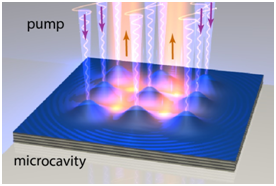Spin lattices of polariton condensates for quantum sumulation
 Optical lattices have attracted much attention, since they can replicate quantum phase transition between the superfluid and Mott-insulating states of the Bose-Hubbard model. By experimentally modifying the lattice depth, one can control the relative strengths of the on-site interaction and inter-site hopping amplitude, Such systems have been of particular interest in the quantum information community since they realize a nearly ideal quantum simulator of the Hubbard model. The macroscopic nature of exciton-polariton condensates provides ease of optical access and probing of individual lattice sites. Furthermore, the non-equilibrium nature of exciton-polariton systems is particularly attractive, because it enables the preparation and study of non-equilibrium many-body phases in a naturally driven dissipative setting and permits in situ optical probing of these phases. The emerging field of polaritonics can be used for practical applications as the basis for quantum simulators.
Optical lattices have attracted much attention, since they can replicate quantum phase transition between the superfluid and Mott-insulating states of the Bose-Hubbard model. By experimentally modifying the lattice depth, one can control the relative strengths of the on-site interaction and inter-site hopping amplitude, Such systems have been of particular interest in the quantum information community since they realize a nearly ideal quantum simulator of the Hubbard model. The macroscopic nature of exciton-polariton condensates provides ease of optical access and probing of individual lattice sites. Furthermore, the non-equilibrium nature of exciton-polariton systems is particularly attractive, because it enables the preparation and study of non-equilibrium many-body phases in a naturally driven dissipative setting and permits in situ optical probing of these phases. The emerging field of polaritonics can be used for practical applications as the basis for quantum simulators.
Polariton simulators with weak on-site interactions and nonlinearities can be used to investigate a range of single-particle problems, such as Josephson oscillations of two coupled condensates, transport-related effects like Bloch oscillations, localization through controlled disorder and the effects of weak interactions, as well as more complex 2D phenomena pertaining to materials like graphene in the presence of external fields and aspects of quantum Hall physics. In order to realize quantum simulations of various interacting many-body systems, it will be important to attain stronger nonlinearities and tighter confining potentials, which we aim at in this project.
Our recent experiments have shown that individual polariton condensates can exhibit spontaneous magnetization, and that the spins of pairs of trapped polariton condensates can be controllably aligned . This constitutes a key step towards using trapped polariton condensates to realize interacting bosons of a driven-dissipative spinor Bose-Hubbard model. A lattice of polariton condensates can therefore model a non-equilibrium interacting spin system with unusual properties.
Our first main focus of this project is to use the flexibility of printing lattices of polariton condensates to implement quantum information processing tasks and to develop conceptually new analog quantum simulators (AQS). We aim to enhance on-site and nearest neighbour interactions by engineering polariton dipole moment and using tighter lateral photonic confinement. We also aim to study the spin properties of a closed interacting chain of exciton-polariton condensates as a controllable system to implement complex non-linear spin models out of equilibrium. Furthermore we aim to identify specific problems which can be simulated by the developed AQS.
[1] H. Ohadi et al., Physical Review B, 97, 195109 (2018)
[2] H. Ohadi et al., Physical Review Letters, 119, 067401 (2017)
[3] H. Ohadi et al., Physics Review Letters, 116, 106403 (2016)
[4] H. Ohadi et al.,Physical Review X, 5, 031002 (2015)